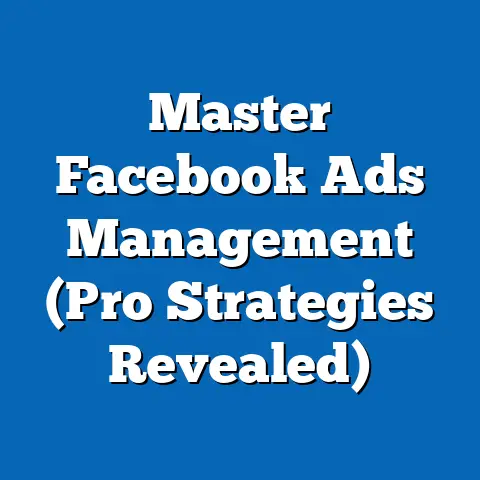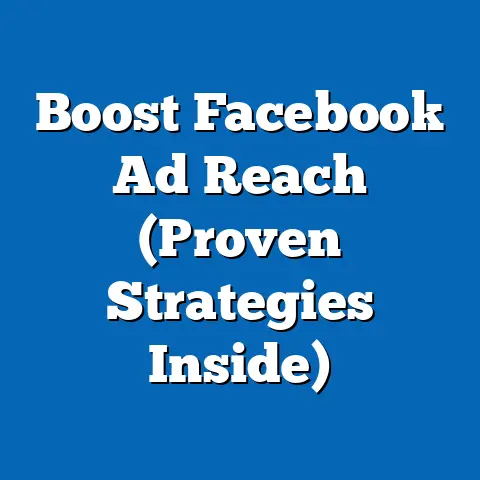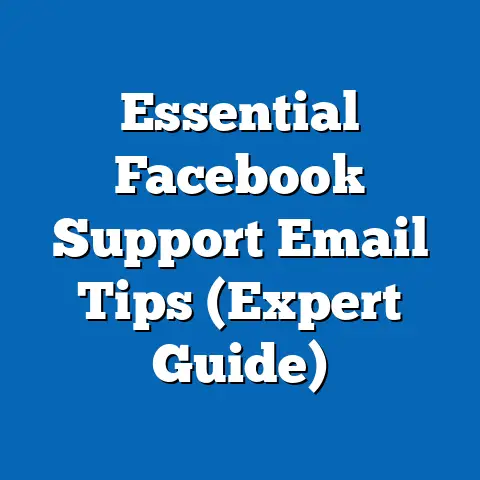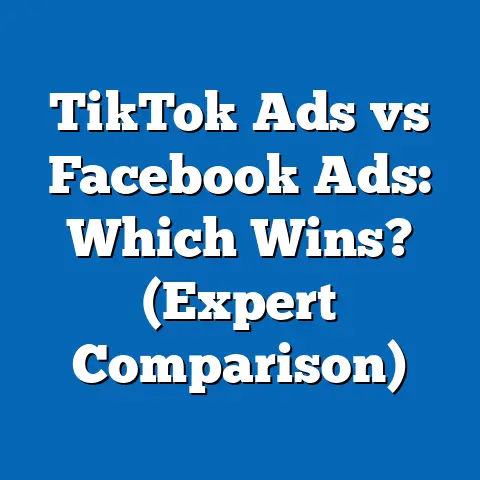Unlock Spy Ads Secrets on Facebook (Insider Strategies)
“The consumer isn’t a moron, she’s your wife.” – David Ogilvy. This quote has always resonated with me because it underscores a fundamental truth about advertising: treat your audience with respect and understand their needs. In the ever-evolving world of Facebook advertising, this rings truer than ever.
Introduction
In the dynamic realm of Facebook advertising, success often hinges on staying one step ahead. One powerful strategy to achieve this is by leveraging “spy ads” – the art and science of analyzing your competitors’ advertising efforts. This isn’t about unethical practices; it’s about intelligent market research and gleaning insights that can significantly boost your campaign performance.
Think of it as understanding the battlefield before entering the war. By carefully observing what your competitors are doing – what visuals they’re using, what messaging resonates with their audience, and how they’re targeting – you can gather invaluable data to refine your own strategy.
In this guide, I’ll share insider strategies to effectively harness the power of spy ads on Facebook. I’ll walk you through understanding the Facebook ad landscape, identifying key elements in competitor ads, and implementing these insights into your own campaigns. My goal is to equip you with the knowledge and tools to transform your Facebook advertising from a guessing game into a data-driven success story.
Understanding Facebook Ads
Facebook advertising has transformed the digital marketing landscape. It’s no longer just a platform for connecting with friends and family; it’s a powerful tool that allows businesses to reach a vast and diverse audience with laser-like precision.
The cornerstone of Facebook advertising lies in its sophisticated targeting options. I’ve been amazed by the sheer depth of demographic, interest-based, and behavioral targeting that Facebook offers. You can target users based on their age, location, interests, hobbies, purchase behavior, and even life events. This level of granularity allows you to create highly personalized ads that resonate with your target audience.
The Facebook Ads Manager is the central hub for creating, managing, and analyzing your ad campaigns. It provides a wealth of data and insights, from basic metrics like impressions and clicks to more advanced metrics like cost per acquisition and return on ad spend (ROAS).
However, the Facebook advertising landscape is incredibly competitive. Millions of businesses are vying for the attention of users, making it crucial to stand out from the crowd. This is where the concept of spy ads comes into play. By keeping a close eye on your competitors, you can gain a competitive edge and avoid costly mistakes. It’s also important to note that Facebook’s advertising algorithms are constantly changing, making continuous monitoring essential.
Takeaway: Understanding the intricacies of Facebook advertising, from its targeting options to its competitive landscape, is crucial for success.
What are Spy Ads?
Spy ads, in essence, are a form of competitive intelligence applied to the realm of digital advertising. They involve the systematic monitoring and analysis of your competitors’ advertising campaigns. The goal is not to copy their strategies outright, but rather to understand what’s working for them, what’s not, and why.
There are several tools and resources available to help you spy on competitor ads. Here are a few popular options that I’ve found useful:
- Facebook Ad Library: This is a free and invaluable resource provided by Facebook itself. It allows you to search for any active ad running on the platform and see the ad creative, targeting options, and other details.
- AdEspresso: This is a paid tool that offers advanced ad analysis features, including competitor tracking and ad performance benchmarking.
- BigSpy: Another paid tool that provides a comprehensive database of Facebook ads, allowing you to search and filter by keywords, industries, and other criteria.
When using these tools, it’s essential to adhere to ethical considerations and best practices. Avoid scraping data without permission, and always respect intellectual property rights. The goal is to gather insights and inspiration, not to steal or replicate your competitors’ work.
I once made the mistake of blindly copying a competitor’s ad copy, only to find that it didn’t resonate with my audience. It taught me a valuable lesson: spy ads should inform your strategy, not dictate it.
Takeaway: Spy ads involve the ethical monitoring and analysis of competitor advertising campaigns to gain insights and inspiration.
The Benefits of Analyzing Competitor Ads
Analyzing competitor ads offers a plethora of benefits that can significantly enhance your Facebook advertising campaigns. Here are some key advantages I’ve experienced firsthand:
- Identifying Successful Strategies: By observing what ads are performing well for your competitors, you can identify successful strategies that are likely to resonate with your target audience. This can save you time and money by avoiding costly experimentation.
- Understanding Audience Engagement: Competitor ad analysis can provide valuable insights into how your target audience interacts with different types of ads. You can see what visuals, messaging, and calls to action are most effective in driving engagement.
- Spotting Industry Trends: By monitoring competitor ads, you can stay abreast of the latest industry trends and adapt your campaigns accordingly. This can help you maintain a competitive edge and avoid falling behind.
I remember a time when I was struggling to generate leads for my business. After analyzing my competitors’ ads, I noticed that they were using a specific type of lead magnet that I hadn’t considered. I decided to create my own version of the lead magnet, and it ended up significantly boosting my lead generation efforts.
Learning from both successful and unsuccessful ad campaigns is equally important. By analyzing ads that have failed to gain traction, you can identify common pitfalls to avoid in your own campaigns.
Takeaway: Analyzing competitor ads provides invaluable insights into successful strategies, audience engagement, and industry trends.
Key Elements to Look for in Competitor Ads
When analyzing competitor ads, it’s crucial to focus on key elements that can provide actionable insights. Here’s a breakdown of the critical components I always examine:
- Visuals: The imagery, colors, and design aesthetics used in the ad play a significant role in capturing attention and conveying the message. Pay attention to the types of visuals that are used, the emotions they evoke, and how they align with the brand’s overall identity. Are they using lifestyle images, product shots, or animated videos? What colors are they using and what emotions do they evoke?
- Copywriting: The headlines, ad copy, and calls to action (CTAs) are essential for persuading users to take action. Analyze the language used, the tone of voice, and the value proposition offered. Does the copy speak directly to the target audience’s pain points? Is the CTA clear, concise, and compelling?
- Targeting: Understanding the audience demographics and interests targeted by the ad can provide valuable insights into your own targeting strategy. Look for clues in the ad copy, visuals, and landing page content. Are they targeting a specific age group, location, or interest category?
- Engagement Metrics: The likes, shares, comments, and overall engagement levels of the ad can indicate its effectiveness. A high engagement rate suggests that the ad is resonating with the target audience. Is the ad generating a lot of likes, shares, and comments? What are people saying in the comments section?
I recommend documenting your findings in a spreadsheet or other organizational tool. Categorize the ads by industry, competitor, and key elements, and note any patterns or trends that you observe. This will make it easier to analyze the data and draw meaningful conclusions.
Takeaway: Analyzing visuals, copywriting, targeting, and engagement metrics in competitor ads can provide actionable insights for your own campaigns.
Implementing Spy Ad Insights into Your Strategy
Once you’ve gathered insights from competitor ad analysis, the next step is to implement them into your own advertising strategy. Here’s how I approach this process:
- Tailoring Your Ad Copy: Use the insights gained from analyzing competitor ad copy to craft headlines, ad copy, and CTAs that resonate with your target audience. Experiment with different language, tones of voice, and value propositions to see what works best.
- Refining Your Visuals: Incorporate the visual elements that you’ve observed in successful competitor ads into your own ad creatives. This could involve using similar imagery, colors, or design aesthetics. However, make sure to maintain your own brand identity and avoid simply copying your competitors.
- Optimizing Your Targeting: Use the insights gained from analyzing competitor targeting to refine your own targeting strategy. Experiment with different demographic, interest-based, and behavioral targeting options to reach the most relevant audience.
Testing and optimization are crucial for maximizing the effectiveness of your ad campaigns. Use A/B testing to compare different ad variations and identify the best-performing elements. Continuously monitor your campaign performance and make adjustments as needed based on the data.
I once ran an A/B test comparing two different headlines for my ad. One headline was based on a competitor’s successful ad copy, while the other was a completely original headline. To my surprise, the original headline significantly outperformed the competitor-inspired headline. This taught me that while spy ads can provide valuable insights, it’s essential to test and validate your own ideas.
Takeaway: Implement spy ad insights by tailoring your ad copy, refining your visuals, and optimizing your targeting, while continuously testing and optimizing your campaigns.
Real-Life Case Studies
To illustrate the power of spy ads, let’s examine a few real-life case studies of brands that have successfully utilized this technique:
- Case Study 1: E-commerce Brand Boosts Sales by 30%: An e-commerce brand selling handmade jewelry noticed that its competitors were heavily promoting their products using influencer marketing. The brand decided to partner with several micro-influencers in its niche, and the campaign resulted in a 30% increase in sales.
- Case Study 2: SaaS Company Increases Lead Generation by 25%: A SaaS company offering project management software analyzed its competitors’ ads and noticed that they were using a specific type of lead magnet – a free project management template. The company created its own version of the template and offered it as a lead magnet, resulting in a 25% increase in lead generation.
- Case Study 3: Local Restaurant Drives Foot Traffic with Targeted Ads: A local restaurant noticed that its competitors were running ads targeting specific demographics within a certain radius of their location. The restaurant implemented a similar targeting strategy and offered a special discount to local residents, resulting in a significant increase in foot traffic.
These case studies demonstrate the diverse ways in which spy ads can be used to enhance Facebook advertising campaigns. The key is to identify the insights that are most relevant to your business and implement them in a way that aligns with your brand identity and overall marketing goals.
Takeaway: Real-life case studies demonstrate the diverse ways in which spy ads can be used to enhance Facebook advertising campaigns.
Conclusion
In conclusion, understanding and implementing spy ad strategies can significantly improve your Facebook ad performance. By analyzing your competitors’ advertising efforts, you can gain valuable insights into successful strategies, audience engagement, and industry trends.
Remember to focus on key elements such as visuals, copywriting, targeting, and engagement metrics when analyzing competitor ads. Use these insights to tailor your ad copy, refine your visuals, and optimize your targeting. And always remember to test and optimize your campaigns using A/B testing and performance metrics.
The Facebook advertising landscape is constantly evolving, so it’s essential to continuously explore and adapt your advertising strategies using insights gained from competitor analysis. By staying one step ahead of the competition, you can maximize your ROI and achieve your advertising goals.
Call to Action
I’d love to hear about your experiences with competitor analysis in Facebook ads. What strategies have you found most effective? What challenges have you encountered? Share your thoughts in the comments below!
And don’t forget to stay updated with the latest trends in digital marketing by subscribing to my newsletter and following me on social media. Together, we can navigate the ever-changing world of Facebook advertising and achieve success.






